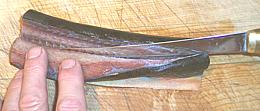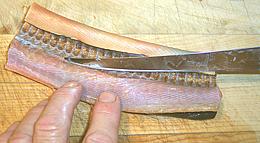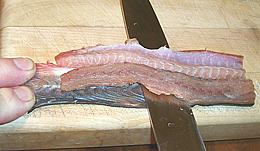Fillet

First cut

Horizontal cut

Bottom cut

Fold and sever

Filleted

Skinning
This fish has become popular enough that it's being farm raised in Vietnam. The flesh of this fish is medium flavor and still very firm when wet cooked. It does not flake, but breaks up easily. It will work fine in soups and stews. In texture and flavor it reminds me somewhat of shark, though they are in no way whatever related.
I rather like this fish as poached fillets, served with my standard Lemon Wine Sauce. The flavor is good, and I like the contrast between the firm flesh and the gelatinous skin. Skin-on fillets don't curl much when added to the poaching liquid.
Buying: This fish is fairly common in the large Asian fish markets here in Southern California, either on ice, or frozen, curled up in a shrink wrapped foam tray. The photo specimen was purchased from a large Asian market in Los Angeles (San Gabriel).
Scales: None. This fish makes no attempt to be Kosher.
Cleaning: In my experience, they are always factory cleaned before shipping to North America. There's plenty inside them as the body cavity extends from the head to not far from the tip or the tail.
Skin: The skin on this eel shrinks like crazy when fried, but so does the membrane on the inside of body cavity. frying fillets skin-on or skin-off is going to result in some twisted fish. It does not curl much with wet cooking as the skin becomes gelatinous almost instantly.
Fillet: You would think a fish with a narrow body cavity over 2 feet long would be a real rib problem, but this fish doesn't actually have any ribs. It has a long backbone with short projections where ribs should be, but they go no farther.
- Clean the eel if it wasn't cleaned at the fish factory and chop into segments of the desired length. A razor sharp Chinese cleaver knife driven by a soft faced mallet is excellent for that purpose. If you'll want very short pieces cut to multiple length for easier handling and cut shorter later. The short tail part aft of the body cavity is rather difficult to deal with and has little meat on it.
- Make a lengthwise cut along the fin line from the top down. There's no actual fin but there are short bones projecting upward from the backbone as with other fish. Your knife will be stopped when it reaches the horizontal bones.
- Now make another lengthwise cut folding the fillet away from the backbone and following the horizontal bones - don't go too far, just to their ends.
- Flip the fish and and do the same as that previous cut but from the underside - again, not too far.
- Finally fold the top and bottom of the fillet skin to skin and hold it together as you cut along the tips of the horizontal bones with kitchen shears. It should feel like you're cutting through cartilage. This will free the fillet from the backbone.
- Now do the other side the same way and you'll have two fillets and a triangular backbone.
- Some recipes call for skinning eel and some don't. The standard technique with American eels is to hang the eel by it's head before cleaning, cut the skin around the head and then pull it down and off the tail. On this eel the skin adheres really tightly, and it is usually already cleaned, but the standard cutting board and long knife method works fine.
